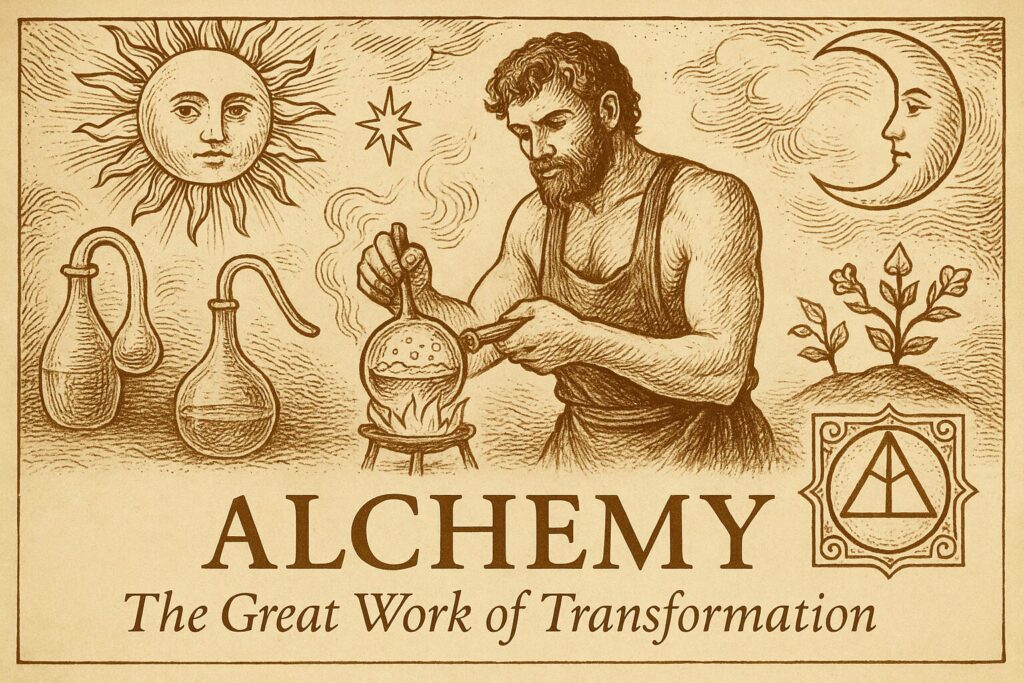Alchemy: The Great Work of Transformation

Alchemy is the oldest dream of transformation—the art that sought to turn base matter into gold, mortality into spirit, and the human soul into a vessel of divine light. Beneath the symbols of furnaces, flasks, and retorts, alchemy is a language of spiritual evolution disguised as metallurgy. From the Alexandrian laboratories of the late Hellenistic world to the monasteries and hidden studies of medieval Europe, its adepts believed that the physical and spiritual realms were reflections of one another. To perfect matter was to perfect the self.
The earliest alchemists called themselves philosophers, not chemists. They inherited from Hermetic Egypt the idea that all things were bound by correspondence—the “as above, so below” of The Emerald Tablet. They saw in mercury, sulfur, and salt not mere substances but the trinity of spirit, soul, and body; in the changing colors of the alembic, the passage of consciousness from shadow to illumination. What they pursued through experiment was the same thing mystics sought through prayer: union with the divine pattern that orders creation.
In the medieval period, alchemy flourished as both a spiritual discipline and a coded language. The Christianized alchemists of Europe—figures like Albertus Magnus, Roger Bacon, and the anonymous adepts of the Rosarium Philosophorum—saw Christ himself as the Philosopher’s Stone, the matter perfected through death and resurrection. Yet beyond the cloisters, Jewish and Islamic scholars preserved older, freer forms of the art: the iksir of Arabic alchemy, the Kabbalistic transformation of the soul, and the Persian dream of the elixir vitae. In all its forms, alchemy sought a single truth—that the universe was alive, mutable, and capable of redemption through the agency of human consciousness.
Alchemy’s symbols are many-layered. The Prima Materia—the chaotic raw substance of existence—must be purified through the opus magnum, the Great Work, which unfolds through color and phase. First comes nigredo, the blackening: dissolution, decay, and the death of the old self. Then albedo, the whitening: purification and the birth of new clarity. Then citrinitas, the yellowing: the dawning of illumination. Finally, rubedo, the reddening: the union of opposites, the marriage of sun and moon, the creation of the Stone. This cycle is as much inner as outer. To the true alchemist, the crucible is the heart, the furnace is the will, and the gold sought is consciousness transmuted into wisdom.
Socially, alchemy straddled worlds. In monasteries it was sanctified as natural philosophy; in village huts it was whispered as witchcraft. Wealthy patrons funded laboratories; solitary seekers worked in secrecy by candlelight. A learned man experimenting with metals was called a philosopher; a woman brewing herbal elixirs might be condemned as a witch. Yet both sought healing and transmutation. In this sense, witchcraft and alchemy share a common lineage—the will to collaborate with nature’s hidden forces rather than dominate them.
By the Renaissance, alchemy had become both a laboratory science and a visionary language. Paracelsus declared that the true physician must be both chemist and magician, for illness was as much spiritual as material. His writings joined the alchemical furnace with the human body, describing the elements as living archetypes and metals as embodiments of planets and gods. Later, in the esoteric revivals of the seventeenth and eighteenth centuries, alchemy merged with Rosicrucian and Hermetic philosophy, influencing everything from Freemasonry to modern psychology.
Carl Jung, in the twentieth century, reinterpreted alchemy as the symbolic language of individuation—the psyche’s process of becoming whole. To him, the Great Work was the reconciliation of the conscious and unconscious, the integration of shadow and light. The philosopher’s stone was not a mineral but the Self, the center of total realization. His insight restored alchemy to its original dignity: not primitive chemistry, but a psychology of the soul’s evolution.
For witches, alchemy’s resonance lies in its view of nature as animate and reciprocal. The elements—earth, air, fire, and water—are not inert matter but living forces capable of purification and rebirth. To blend herbs, to distill oils, to transmute the intention of a spell from pain into power—these are alchemical acts. Every charm is a miniature Great Work, every circle an alembic of transformation. Where the alchemist labored toward the philosopher’s stone, the witch seeks the perfected will: both are metaphors for union with the living current of creation.
Yet alchemy, like all potent arts, demands patience and balance. Its symbols warn of hubris. The same fire that purifies may consume; the same dissolving that frees may destroy. “Solve et coagula”—dissolve and bind—is its eternal rhythm, and to master it is to accept that every act of change requires a sacrifice. The Great Work is never finished, for it is life itself unfolding through time, learning to become gold without forgetting it was once lead.
Alchemy’s influence persists across occult and spiritual traditions: in the Rosicrucian manifestos, the Emerald Tablet of Hermes, the Golden Dawn’s elemental correspondences, even the language of modern witchcraft and magic. Wherever transformation is the goal—whether of metal, soul, or world—the alchemical current flows beneath the surface.
To speak of alchemy, then, is to speak of the human condition itself: the restless desire to refine, redeem, and reveal the divine hidden in matter. Its laboratory is both the earth and the heart. Its fire is the light of consciousness. Its stone, the perfected spirit shining at the end of all transformations.

